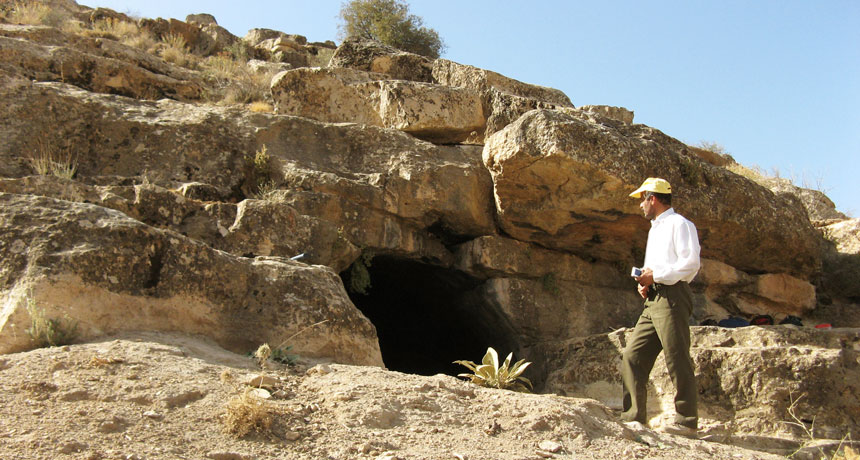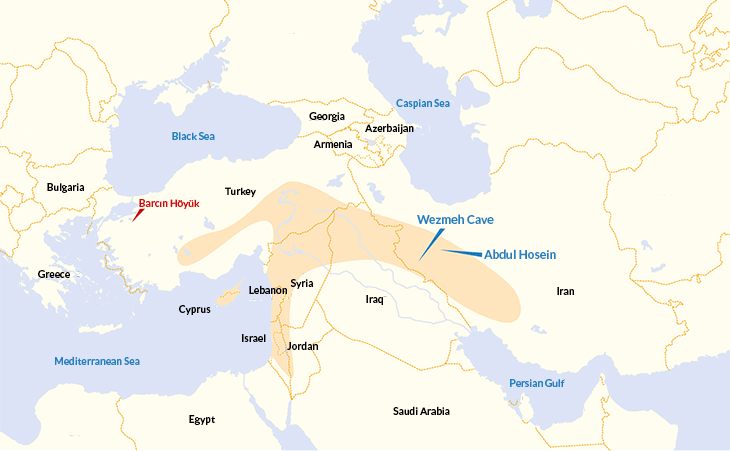Two groups spread early agriculture
Fertile Crescent cultures diverged to take farming east and west

FOUNDING FARMERS A bone fragment from a 7,000-year-old farmer was discovered in this cave in the Zagros region of Iran. His DNA and the DNA of three other individuals from a second Iranian site revealed that two different groups were involved in early farming.
Fereidoun Biglari
- More than 2 years ago
The cradle of agricultural civilization was culturally diverse.
Two societies lived side-by-side 10,000 years ago in the rich Near Eastern valleys of the Fertile Crescent, where humans first learned to farm, a new study finds. Over time, one group expanded west, carrying agriculture into Europe. The other spread east, taking their traditions into South Asia, researchers report online July 14 in Science.
“We thought the people of the Fertile Crescent were one group genetically and culturally, but in fact they were probably two or more,” says paleogeneticist Joachim Burger of Johannes Gutenberg University Mainz in Germany, who led the new study. It’s time to rethink the textbook idea that modern Europeans and South Asians descend from a single Stone Age people, he says.
Earlier this year, Burger’s team reported in the Proceedings of the National Academy of Sciences that the first European farmers came from western Anatolia near the present site of Istanbul. Scientists suspected that the Anatolians had started out even further east, at older sites in Iran, Iraq, Syria and southeastern Turkey where farming began about 10,000 years ago.
But DNA from 7,000- to 10,000-year-old remains, found at two ancient Iranian settlements, told a different story. Carbon and nitrogen ratios in bones showed that the people there ate more cultivated cereals than meat. While they were farmers and had lived several thousand years before the Anatolians, genetic analysis showed that the two blood lines were not closely related.

In fact, the two groups had probably separated more than 45,000 years earlier, just after humans left Africa, says statistical geneticist Garrett Hellenthal of University College London, a coauthor of the new study. Even 10,000 years ago, the ancestors of Iranians and Anatolians had already been isolated for 36,000 to 67,000 years.
Evidence of the Anatolian farmers is a few thousand years younger than the Iranian remains, but both cultures “must have known each other to some extent,” Burger says.
People in the two groups probably looked different and spoke separate languages, Burger says. They didn’t intermarry, but undoubtedly shared the ideas of early agriculture. It would have taken centuries to convert from hunting and gathering to an agrarian way of life.
“Domestication of wild beasts is nothing you do over the weekend,” Burger says. And “you don’t invent something crazy and complicated like farming coincidently at the same time.”
Not everyone agrees with that conclusion. “The change from hunting to farming happened probably several times,” says archaeologist Roger Matthews of the University of Reading in England, who was not involved in the new work. While both the Anatolians and Iranians were farmers, “it’s not actually the same idea they’re coming up with,” he says. In the east, early agrarians focused on goats as well as barley and wheat, while in the west, shepherds raised sheep and other foods. Both communities probably took initial but separate steps toward farming, Matthews says.
Sometime after farming was developed, the two cultures began to move apart. Why they spread so differently is still a mystery. More DNA samples from ancient people east of the Fertile Crescent are necessary to confirm that people spread from Iran eastward, says anthropologist Christina Papageorgopoulou of the Democritus University of Thrace in Greece. She coauthored the Anatolian study but was not involved in the new work.
More DNA from within the Fertile Crescent could also reveal a border or boundary between ancient Anatolians and Iranians. “I cannot imagine there was a connection,” she says. If there had been, scientists would see have seen it in the DNA. “I think there is some kind of barrier there.”
At this point, scientists can speak broadly about the blood relationships between these early farmers, but more high-quality DNA samples would let researchers zoom in to the village or household scale, to “come closer to ancient humans and how they lived,” Burger says. His vision is to analyze whole Stone Age villages, to reconstruct ancient family trees, understand who migrated where and move “from a global to a village view.”
Editor’s note: This story was updated July 15, 2016, to correct two country labels on the map.







